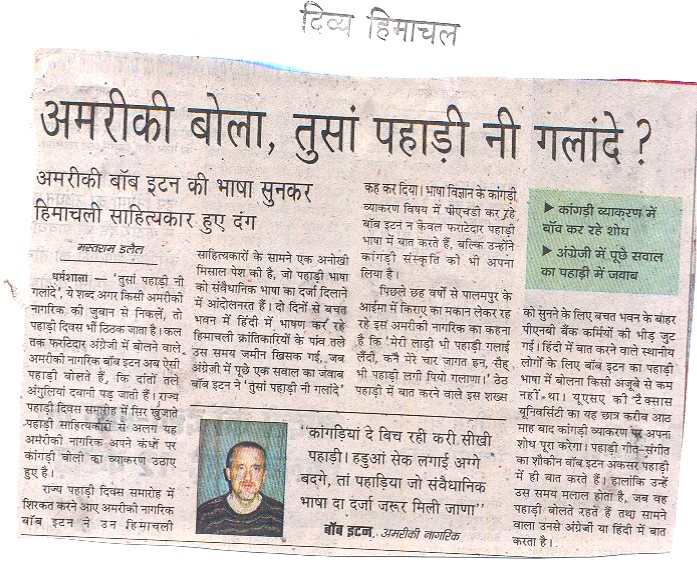
A Graduate in Electrical Engineering with a Master’s Degree in Computer Science, Bob Eaton is currently pursuing his Ph.D. in Linguistics from the University of Texas, Arlington with Kangri as his research subject, Bob has been actively involved with Indic Computing.
How did your interest in Hindi and Kangri languages come about? What special feature of these two languages interests you the most?
B: The interest in Hindi was for pragmatic reasons: knowing Hindi helps you to be able to get around India. Also, it is probably the single most well-known language in all of India and relative easy to learn (e.g. compared with English, for example).
Regarding Kangri, I had to choose a language in which to do research for my Ph. D., and Kangri was a great fit. It has a fair number of speakers, who have a positive language attitude, and has not had as many things written about it, compared with other major Indian languages.
I read a survey of the language situation in Himachal and took a bus trip to Palampur to see what the climate and people were like. When we came over the hill and saw the Dhuladhar mountain range, and met the most friendly, welcoming people, I felt that my choice was made for me!
How can languages like Kangri be enriched by enabling their scripting through the multilingual support of Windows XP?
B: That’s a difficult question. Kangri is not (yet) written much. There are some poetry books and cultural stories, but there is a lack of standardization in using the Devanagari script. As the local proverb goes, “The language changes every 12 km.” Also, not many people have computers yet.
The good part, though, is that a few of us (myself and a few local scholars) have worked to analyze the sound system of Kangri to make sure we have all the diacritics needed to represent the sounds in Unicode and have come up with what we hope will be the beginning of a standard orthography, based on the Devanagari script.
Is the merger of standards like ISCII and Unicode necessary in the current scenario? If yes, why?
B: Yes. For example, Kangri has a tone which derives from the ‘h’ sound. Historically, people have been using the halant with the ‘h’ to represent this sound (i.e. हà¥â€Œ). But of course, this violates the semantics of the halant in Unicode, since it means that this is the first letter in a consonant conjunct. So we’re encouraging people to use the nyukta instead of the halant so that it doesn’t cause problems with Unicode in the future. I’ve also been working with the folks in the Dogri Department of the Jammu University on this same issue to try to make as much overlap with Kangri as possible. We’re also trying to get another character added to the Devanagari range of Unicode for a different diacritic that Dogri uses for tone. So, we’re trying to make sure that languages like Kangri and Dogri can move forward using the Unicode standard, so that as they continue to take off as written languages, they will have a more workable solution into the future.
News on Divya Himachal:
Â
An IT professional for 17 years, based in the US since the last 12 years. Founded NGO My Himachal and then Himachal Media Pvt. Ltd.. A Himachali forever. Always trying to bring together people whose hearts beat for the state.



